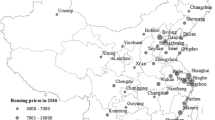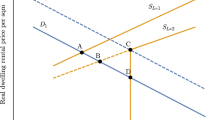Abstract
Change in the level of residential construction affects macroeconomic conditions and is an important determinant of movements in house prices. Theory teaches us that increases in the cost of construction should reduce the supply of new housing. Yet empirical research has failed to find a consistent relationship between these costs and housing starts. This article introduces an entirely new set of micro-data on housing construction costs to study this issue. We develop quality-controlled, hedonic construction cost series from these data. Using this series, we estimate housing supply and construction cost functions for new single-family residences. This research demonstrates that bias in the commercial cost indexes used in existing housing supply studies is a likely cause of their poor performance in existing estimates of the supply of new single-family housing. The bias appears to be caused by an incorrect measure of labor costs and a failure to address the endogeneity of construction costs and construction activity. In contrast, starts regressions using the hedonic cost series generate much more sensible results. We find that housing starts are quite cost elastic; construction costs are endogenous in the new housing supply function, and the cost shares of material and labor in the structure of new residences are approximately 65 and 35%, respectively.
Similar content being viewed by others
References
Bourdon, Clinton C. (1976). ``Demand Instability and the Labor Force in the Construction Industry,'' Working Paper No.37, Joint Center for Urban Studies of MIT and Harvard University.
Capozza, Dennis R., and Robert W. Helsley. (1989). ``The Fundamentals of Land Prices and Urban Growth,'' Journal of Urban Economics26(November),295–306.
Cassimatis, P. J. (1969). Economics of the Construction Industry. New York: National Industrial Relations Conference Board, Studies in Business Economics No. 111.
Clemhout, Simone. (1981). ``The Impact of Housing Cyclicality on the Construction of Residential Units and Housing Costs,'' Land Economics57(November),609–623.
Coulson, N. Edward, and Christian Richard. (1996). ``The Dynamic Impact of Unseasonable Weather on Construction Activity,'' Real Estate Economics24(Summer),179–194.
DiPasquale, Denise, and William C. Wheaton. (1994). ``Housing Market Dynamics and the Future of Housing Prices,'' Journal of Urban Economics35(January),1–27.
Eccles, Robert. (1981). ``The Quasi-®rm in the Construction Industry,'' Journal of Economic Behavior and Organization2,335–358.
Edelstein, Robert H. (1983). ``The Production Function for Housing and its Implications for Future Urban Development,'' In G.W. Gau and M. A. Goldberg, eds., North American Housing Markets: Into the Twenty-First Century (pp. 93–125). Cambridge, MA: Ballinger.
Follain, James R. (1979). ``The Price Elasticity of the Long-Run Supply of New Housing Construction,'' Land Economics55(November),190–199.
Goodman, J. (1987). ``Housing and the Weather,'' Journal of the American Real Estate and Urban Economics Association15(Spring),638–663.
Holland, Steven A. (1991). ``The Baby Boom and the Housing Market: Another Look at the Evidence,'' Regional Science and Urban Economics21,565–571.
Kinzy, Scott. (1992). ``An Analysis of the Supply of Housing Characteristics by Builders Within the Rosen Framework,'' Journal of Urban Economics32(July),1–16.
Klein, B., and K. Lef¯er. (1981). ``The Role of Market Forces in Assuring Contractual Performance,'' Journal of Political Economy89(August),615–641.
Maisel, Sherman J. (1953). Housebuilding in Transition. Berkeley: University of California Press.
Malpezzi, Stephen, and Duncan Maclennan. (1996). ``The Long-Run Price Elasticity of New Residential Construction in the United States and the United Kingdom,'' Mimeo, University of Wisconsin, Department of Real Estate and Urban Land Economics.
Manski, Charles F., and Kenneth T. Rosen (1978). ``The Implications of Demand Instability for the Behavior of Firms: The Case of Residential Constructions,'' AREUEA Journal6,204–226.
Mayer, Chris B., and C. Tsuriel Somerville. (1996). ``Regional Housing Supply and Credit Constraints,'' New England Economic Review (November-December),39–51.
Mayer, Chris B., and C. Tsuriel Somerville. (1997). ``Unifying Empirical and Theoretical Models of Housing Supply,'' Working Paper, Federal Reserve Bank of Boston.
McDonald, John F. (1981). ``Capital-Land Substitution in Urban Housing: A Survey of Empirical Estimates,'' Journal of Urban Economics9(March),190–211.
Meese, Richard, and Nancy Wallace. (1994). ``Testing the Present Value Relation for House Prices: Should I Leave My House in San Francisco?'' Journal of Urban Economics35(May),245–266.
Muth, Richard. (1960). ``The Demand for Non-Farm Housing,'' In A.C. Harberger, ed., The Demand for Durable Goods. Chicago: University of Chicago Press.
Olsen, Edgar O. (1987). ``The Demand and Supply of Housing Service: A Critical Survey of the Empirical Literature,'' In E. S. Mills, ed., Handbook of Regional Science and Urban Economics (Vol.2, pp. 989–1022).
Potepan, Michael. (1996). ``Explaining Intermetropolitan Variation in Housing Prices, Rents, and Land Prices,'' Real Estate Economics24(Summer),219–246.
Poterba, James M. (1984). ``The Subsidies to Owner Occupied Housing: An Asset Market Approach,'' Quarterly Journal of Economics99(November),729–752.
Poterba, James M. (1991). ``House Price Dynamics: The Role of Tax Policy and Demography,'' Brookings Papers on Economic Activity2,143–203.
Quigley, John. (1982). ``Residential Construction and Public Policy: A Progress Report,'' In R. Nelson, ed., Government and Technical Progress. (pp. 361–410). New York: Pergamen Press.
Rosenthal, Stuart S. (1999). ``Residential Buildings and the Cost of Construction: New Evidence on the Ef®ciency of the Housing Market,'' Review of Economics and Statistics (May) forthcoming.
Shapiro, Carl. (1983). ``Premiums for High Quality Products as Rents to Reputation,'' Quarterly Journal of Economics98(November),659–679.
Smith, Larry B., Kenneth T. Rosen., and George Fallis (1998). ``Recent Developments in Economic Models of Housing Markets,'' Journal of Economic Literature26(March),29–64.
Somerville, C. Tsuriel. (1996). ``The Contribution of Land and Structure to Builder Pro®ts and House Prices,'' Journal of Housing Research7,127–142.
Stover, Michael E. (1986). ``The Price Elasticity of the Supply of Single-Family Detached Urban Housing,'' Journal of Urban Economics20(November),331–340.
Topel, Robert, and Sherwin Rosen. (1988). ``Housing Investment in the United States,'' Journal of Political Economy96(August),718–740.
Willis, Mark A. (1979). ``The Effects of Cyclical Demand on Industry Structure and the Rate of Technical Change,'' Ph.D. dissertation, Yale University.
Author information
Authors and Affiliations
Rights and permissions
About this article
Cite this article
Somerville, C.T. Residential Construction Costs and the Supply of New Housing: Endogeneity and Bias in Construction Cost Indexes. The Journal of Real Estate Finance and Economics 18, 43–62 (1999). https://doi.org/10.1023/A:1007785312398
Issue Date:
DOI: https://doi.org/10.1023/A:1007785312398




